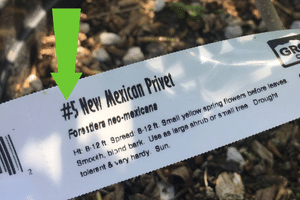Nursery Container Sizes
Page top image size: 1000 x 500 px
Nursery Container Sizes

Have you ever looked at a plant tag and wondered what the numbers mean? For example, Common Lilac #2 or Bur Oak #10?
Those numbers refer to the size of the container the plant is in, and therefore, the size of the plant itself. When shopping at Rick’s and other nurseries, you’ll notice that nursery plants are sold in containers labeled #1, #2, #3, #5, etc.
It would be so convenient if a #5 pot was equal to 5 gallons, but unfortunately that’s not the case. The companies who manufacture nursery containers have a lot of variation in their products.
Fortunately, there is some standardization with nursery pots, thanks to the ANSI American Nursery Stock Standard. Here’s the standard range of volume by container size:
| Nursery Container Size | Minimum Volume | Maximum Volume |
| #1 | 0.7 gallons | 1.1 gallons |
| #2 | 1.4 gallons | 2.1 gallons |
| #3 | 2.7 gallons | 3.2 gallons |
| #5 | 3.4 gallons | 5.4 gallons |
| #7 | 5.8 gallons | 7.7 gallons |
| #10 | 9.0 gallons | 11.5 gallons |
| #15 | 12.0 gallons | 16.0 gallons |
| #20 | 19.6 gallons | 22.3 gallons |
How do I know which container size to choose?
As container plants grow, they fill their pot with roots. Once they reach their maximum size for that pot, they are transplanted into a larger size pot, and so on. Therefore, larger container sizes equate to more mature plants.
Choosing a container size comes down to the preference of the gardener. For example, gardeners who want fuller and more mature plants in their landscape might prefer to plant larger (and therefore more expensive) plants. Other gardeners might prefer to plant smaller (and therefore less expensive) plants which will take a little longer to mature.
Gardeners may also want to consider the length of time it will take a tree or shrub to establish in the soil once transplanted. Larger trees take longer to get established, meaning they will require more monitoring and more supplemental watering.
| Size of Nursery Stock | Time to Establish |
| Less than 2 inch caliper | 1-2+ seasons |
| 2 to 4 inch caliper | 2-4+ seasons |
| Greater than 4 inch caliper | 4+ seasons |
Bottom Line
We know, nursery container sizing can be really confusing, but we’re here to help!
Our nursery staff can talk to you about the specific plants you’re interested in and the location you’re planning to put them in. They will guide you through the care required for each plant, how long it will take for them to establish, and how long it will take for them to mature.
While our store is open year-round, our nursery area is open seasonally – typically from mid-April through September. Please visit us to see our full inventory of plants and to talk to one of our experts!
Back to Home